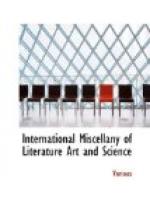“At the time of the death of Queen Elizabeth, one hundred and eleven years subsequent to the great discovery of the Western World by Columbus, the Spaniards, on whose behalf his discovery had been made, were the sole permanent settlers in this wide and wealthy continent. In 1606, the French began to make settlements in Canada and Acadie, now Nova Scotia, but it was not till 1607 that the enterprise, which was finally destined to lay the foundation of British occupancy of American soil, was undertaken. Twenty-three years had expired since the patent has been granted to Sir Walter Raleigh to discover and take possession, with little less than royal privileges, of remote heathen and barbarous lands, hitherto not actually possessed by any Christian prince; and yet not an acre of American soil had hitherto become the property of the English..... It was shortly after this period, viz., A deg. 1605-6, that Richard Hakluyt, the ‘presidium et dulce decus’ of our Society, to whom, as Robertson justly remarks, ’England is more indebted for its American possessions than to any man of that age,’ used influential arguments with various gentlemen of condition, to induce them to present a petition to King James to grant them patents for the settlement of two plantations on the coast of North America. This petition issued in the concession of a charter, bearing date the 10th of April 1606, by which the tract of country lying between the thirty-forth and forty-fifth degrees of latitude was to be divided into nearly equal portions, between two companies; that occupying the southern portion to be called the first colony (subsequently named the London Company), and that occupying the northern, to be called the second colony (subsequently named the Plymouth Company). The patent also vested in each colony a right of property over fifty miles of the land, extending along the coast each side of the point of first occupation, and a hundred miles inland. The chief adventurers in the London or South Virginian Company, with which as the first settlement we now have principally to do, were Sir Thomas Gates, Sir George Somers, Richard Hakluyt, and Edward Maria Wingfield. The command of the expedition was committed to Captain Newport.”
“By a strange caprice of the king, these instructions were sent carefully sealed up and inclosed in a box, not to be opened till their arrival in Virginia.” Thus, destitute of a leader at the time when they most needed one, they chose the gallant Captain John Smith, so well known from “the romantic tale of his own life and Englishmen’s lives, for his sake, being saved once and again, by the personal devotion of the generous but ill-requited Pocahontas.” Under him the first permanent settlement of the English in America was effected, and James Town built. In 1609 the expedition under Lord Delaware set out; and “under his enlightened and beneficent auspices the colony soon assumed a wholesome and active appearance.” Ill health, however, compelled him within two years to return to England: but Sir Thomas Dale arriving soon after, with a fresh supply of emigrants, the colony continued prosperous, its affairs subsequently retrograded; and Lord Delawarr again went out in the year 1618,—but unfortunately only to die, near the bay which still bears his name.




